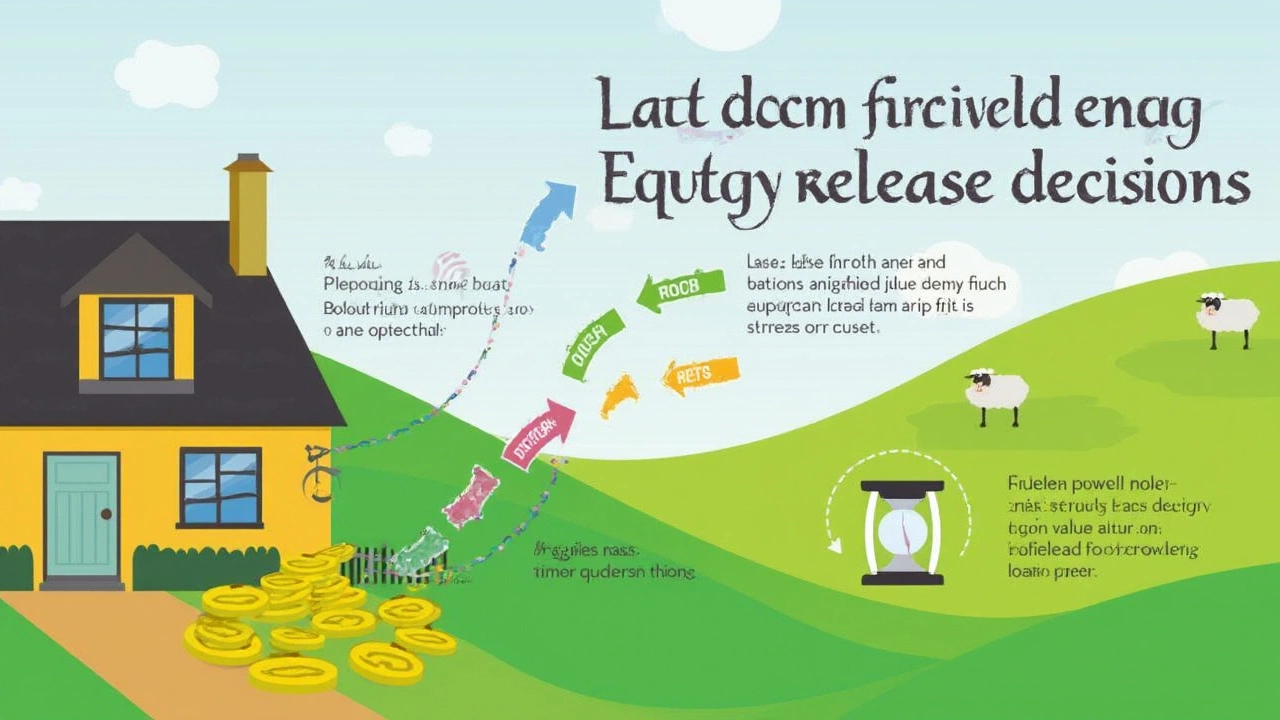Ever wondered how you can tap into the money tied up in your home? That's what we call equity release. It's a nifty way for folks, especially those in retirement, to access funds without selling up. But how much can you actually release? Well, that depends on a few things.
First off, you need to understand what 'equity' means. It's the difference between your home's market value and any remaining mortgage. Think of it like a piggy bank that's been growing over the years, thanks to your diligent payments and maybe some market growth.
But here's the kicker: the amount you can unlock isn't just about your home's value. It's also influenced by stuff like your age and the type of plan you choose. The older you are, typically, the more you might be able to release. So, strategic planning could be your best friend here.
- Understanding Equity Release
- How Much Equitable Value?
- Factors Affecting Equity Release
- Types of Equity Release Schemes
- Tips for Maximizing Equity
- Potential Risks and Considerations
Understanding Equity Release
Equity release might sound like a complex financial wizardry, but it's actually simple. It allows homeowners, mainly those in retirement, to unlock the money built up in their property without having to sell it. Think of it as a way to enjoy what you've invested in over the years while still having a roof over your head.
So, how does it work? In a nutshell, you borrow against the value of your home. Unlike regular loans, there's typically no need to repay the loan until you sell the home, move into long-term care, or pass away. It's crucial to wrap your head around the fact that while you're accessing cash, you're also reducing your estate's value.
Different Types of Equity Release
There are mainly two types: lifetime mortgages and home reversion plans. With a lifetime mortgage, you take a loan secured against your home. The loan and any interest accumulate until you die or move. Most folks prefer this because you retain full ownership of your home.
Home reversion plans, on the other hand, involve selling a portion or all of your home to a reversion company. You'll get a lump sum or regular payments, and in return, live rent-free in the property for the rest of your life.
Who Can Use Equity Release?
Typically, you need to be at least 55 to apply for a lifetime mortgage and 65 for a home reversion plan. The more experienced in years, the better, as this can affect how much you can release.
Wondering if this is right for you? Consider your current financial situation, your future needs, and chat with a financial advisor who knows the ins and outs of equity release. Makes sense, right?
How Much Equitable Value?
So, you're curious about how much of your home's value you can actually get your hands on? The answer isn't exactly one-size-fits-all, but I'm here to break down the basics for you. And it all begins with understanding the balance between your home's current market value and any remaining mortgage. That's your home equity, simple as that!
Now, let's talk specifics. The amount of equity release you can snag depends on a couple of key things: your age and the property's value. Take note: the older you get, the higher the percentage of your home’s value you're likely to access. It's a bit of a reverse birthday gift, if you will.
Calculating Your Potential Release
Imagine your home is worth $600,000, and you still owe $100,000 on your mortgage. Your equity, in this case, stands at $500,000. Sounds good, huh? But can you access the full amount right away? Not quite. Most plans only offer a portion of your available equity.
The percentage often ranges from 20% to 60%, based on factors like your age at the time of application. The table below gives you a rough idea of potential outcomes:
| Age | Potential Equity Access |
|---|---|
| 55 | 20%-30% |
| 65 | 30%-40% |
| 75 | 40%-55% |
| 85+ | 50%-60% |
Interest rates also play a role. Generally, lower rates might boost the amount you could release. The catch here is that they can vary widely depending on the market and your personal circumstances.
Data-Driven Insights
Here's another tidbit: in Australia, as of late 2023, the average equity release was about 40% of the home value. This is nothing to sneeze at, considering the future security it provides.
If you're pondering this path, armed with these insights, start by chatting with a financial advisor. They'll consider all the nitty-gritty details and help you figure out what's best for your financial health.
Factors Affecting Equity Release
When it comes to figuring out how much equity you can release from your house, several factors come into play. Understanding these can help you navigate your options and make the most of what's yours.
Home Value
Let's start with the obvious: the value of your home. The more it's worth, the more equity you've got to work with. It’s a bit like gold—hanging onto a property as its value increases means there could be more for you to access when the time comes.
Age
Your age is another big player. Typically, the older you are, the higher the percentage of equity you can release. Lenders often use this criterion under the assumption that the loan period will be shorter.
Interest Rates
Interest rates can either work for or against you. A lower rate is usually better because it means less cost if you're going the route of a loan or mortgage-type plan. Keeping an eye on the current rates before you call your lender can save you money down the road.
Type of Equity Release Plan
There's more than one way to skin a cat, and the same goes for equity release plans. Whether you opt for a lifetime mortgage or a reversion plan, each has different rules, benefits, and impacts on how much equity you can pull out.
Property Type
Not all houses are created equal in the eyes of lenders. Factors such as the property type, condition, and location can influence your options. An apartment may offer different possibilities compared to a standalone house.
| Factor | Impact on Equity Release |
|---|---|
| Home Value | Higher value equals more equity |
| Age | Older equals potentially more release |
| Interest Rates | Lower rates are usually beneficial |
| Property Type | Different impacts based on type and location |
In a nutshell, knowing what impacts equity release can help you figure out the best time and way to access what you've invested in your home. It’s always recommended to have a chat with a financial advisor to tailor it all to your personal situation.

Types of Equity Release Schemes
When it comes to equity release, you've got a couple of main routes to think about. Each has its own perks and potential downsides, so knowing your options is key.
Lifetime Mortgage
This is probably the most popular choice out there. In a nutshell, you borrow a portion of your home's value. Here's the kicker: you don't make monthly repayments. Instead, the interest compounds over time and gets paid back when you sell your home or pass away. It’s simple and straightforward. But a heads up—you might end up owing a lot more than you borrowed thanks to that compounding interest.
Home Reversion
Not as common as the lifetime mortgage, but still worth a look. With a home reversion scheme, you sell a part or all of your home to a provider in exchange for a lump sum or regular payments. You can stay in your home rent-free, so don’t worry about packing boxes just yet. However, you're often selling your home for less than market value. So while you get money upfront, your heirs might receive a smaller inheritance down the line.
Interest-Only Mortgage
This one's a bit of a hybrid. It lets you borrow against your home equity but with the option to pay off the interest monthly. That way, the amount you owe doesn’t snowball as it does with a lifetime mortgage. Handy, right? Just keep in mind you'll need enough regular income to cover those interest payments.
Other Options
- Drawdown Lifetime Mortgage: A variant where you can take the money in chunks over time instead of a lump sum upfront. Handy if you don't need a huge slice of cash right away.
- Enhanced Lifetime Mortgage: For those with specific health issues, this might allow you to release more funds due to shorter life expectancy. It's the same setup as a regular lifetime mortgage but a little extra cash could be unlocked.
Keep in mind, whatever you go for, chat with an advisor. They can help crunch the numbers and see what fits best for your financial situation.
Tips for Maximizing Equity
Let's talk about getting the most bang for your buck when it comes to equity release. There’s more to it than just cashing in and kicking back. Here’s how to make sure you’re maximizing your home’s potential.
Keep Up With Home Maintenance
A well-maintained home is usually worth more. Simple things like fixing leaky taps or keeping the paint fresh can add value. Regularly checking for any structural issues and addressing them can also help keep your home’s value up there.
Consider Downsizing
If you haven't thought about it before, maybe now’s the time. Moving to a smaller place not only frees up equity, but usually means lower bills. Plus, less space to clean! The extra cash you make on the sale? That’s pure equity boosting right there.
Interest Rate Watching
Interest rates can affect how much equity you can release. Keeping an eye on market trends and timing your release during low-rate periods can make a big difference. It might sound like finance jargon, but it's essentially shopping for bargains.
Choose the Right Plan
There are a couple of main options: lifetime mortgages and home reversion plans. Do your homework or chat with a financial advisor to see which one fits best with your goals. Each has its pros and cons, and suitability depends on your specific situation.
Plan for the Long Run
Think ahead. If you plan to stay in your home for a long time, make sure the plan you pick doesn’t limit your future flexibility. Some plans might affect the inheritance you leave, so it pays to think of the next generations too.
Here’s a quick comparison of the main plans:
| Plan Type | Pros | Cons |
|---|---|---|
| Lifetime Mortgage | No need to move | Interest can accumulate |
| Home Reversion | Cash lump sum | Part of home sold off |
By considering these factors and keeping yourself informed, you can squeeze more out of your home equity. Remember, it's not just a house; it's a significant financial asset!
Potential Risks and Considerations
Jumping into the world of equity release might seem like a great way to access cash, but it's not all sunshine and rainbows. Like all financial products, there are pitfalls to watch out for, and it pays to be aware before signing on the dotted line.
Impact on Inheritance
One of the biggest considerations is how it affects what you leave behind. Releasing equity reduces the value of your estate, which might mean less for your heirs. If leaving a nest egg is important to you, weigh this carefully.
Interest Rates and Debt Accumulation
Equity release plans, especially ones like lifetime mortgages, can result in what some folks call a 'debt time bomb.' The interest on your loan compounds, increasing the amount owed over time. If left unchecked, this could dwarf the amount you initially borrowed.
| Interest Rate | Loan Doubles In |
|---|---|
| 3% | 24 years |
| 5% | 15 years |
This table gives you a rough idea of how quickly debt can grow at different interest rates. Seeing those numbers can be a real eye-opener!
Potential Impact on Benefits
If you're receiving government benefits, check how home equity schemes might affect them. Sometimes, they can reduce your eligibility for certain means-tested benefits. Do your homework to avoid any unpleasant surprises.
Commitment and Costs
Once you've signed up, getting out can be tricky. Early repayment fees can hit hard if you change your mind. Not to mention, setup costs and legal fees might add to the bill, eating into what you initially hoped to gain.
Market and Property Risks
Don't forget that housing markets can be unpredictable. A drop in property value can affect how much equity you'll eventually have left, whether it's for more borrowing or passing down to family.
So, what's the takeaway? Do your due diligence, consult a financial advisor, and make sure equity release is the right move for you. It's all about making informed decisions and avoiding nasty surprises down the track.









